
USB gadget roundup
Review date: 25 November 2004. Last modified 03-Dec-2011.
Nerds can be very difficult to buy for.
By the time we're in our mid-twenties, we've usually got enough income that we've already bought ourselves every toy we want.
Well, OK, not every toy, but the ones that remain tend to exceed most people's Christmas present budget.
It's not just gadgets, either. Someone bought me a Cuddly Cthulhu once, only to discover that I already had one. Thank goodness the one I'd been given was the deluxe black and silver version, versus the plain green I'd bought before, or it could have been awkward.
Heck, even if you notice they've got an ancient green-screen Nokia and buy 'em a new mobile phone, you'll probably find they still had the old one 'cos they dug it. You can't win.
So what present can you buy for the Geek Who Has Everything?
Will you be forced to get them Some Damn Thing from the local Nifty Gifty?
With any luck, no, thanks to places like USB Geek. They stock a bunch of USB-related gear that features varying mixtures of utility and whimsicality, and which most nerds don't have. Or do have, but could use another.
USB Geek's products are also generally quite cheap, especially when you note their flat $US3 shipping policy, no matter where you live in the world and how much stuff you buy. Obviously, this suspiciously low shipping means they're marking up their gadget prices to make up the difference; they're based in Hong Kong, where wholesale prices for everything they sell are rock bottom. But you're still not paying all that much, and buying from USB Geek will save you a trip to your local seedy computer market to hunt for the same stuff.
So: On with the gadgets!
Little black box
USB network adapters didn't start out too well.
At first, when USB was young, compatibility problems were rife and so few computers had USB ports that there wasn't much point buying little pocketable USB gadgets, rather than PCI or PCMCIA cards.
Then things got a bit better - and I wrote this - but USB network adapters still weren't very fast, because USB wasn't very fast.
USB network adapters have supported "10/100" Ethernet for a long time, but until USB 2.0 came along, there was no way for them to come close to filling 100BaseT ("Fast Ethernet") bandwidth. They'd connect to a 100 megabit per second network just fine, without pulling down everything else on their network segment to ten megabit speed (that's not much of an issue nowadays, since even home networks use switches that give every network node its own segment; read more about hubs and switches in my old networking piece here), but the 12 megabit per second peak bandwidth of USB 1.1 meant you'd only ever get about 0.7 megabytes per second of user data through a USB 1.1 network adapter.
This is a USB 2.0 network adapter. It's the size of a thumb. It comes with a little extension cable so you can plug it into USB ports that're crowded by other cables. It should Just Work with current versions of Windows and Mac OS; it'll probably Just Work with current versions of Linux; it comes with a driver floppy for older USB-capable Windows flavours.
USB 2.0 has been a standard feature of new PCs and Macs for some time. Its peak bandwidth is 480 megabits per second; the real usable bandwidth is considerably lower, as usual, but it still has no trouble accommodating 100BaseT. So today's "10/100" USB network adapters can actually work as fast as a regular Network Interface Card (NIC). Gigabit Ethernet still ain't gonna happen at full speed from USB, but 100BaseT is enough for most people.
USB network adapters are, by the way, likely to use more CPU power than even a basic PCI adapter, let alone a proper brand name server-quality NIC, but on modern PCs this shouldn't matter at all.
USB Geek sell this adapter for $US20. Exciting, it is not, but any geek who has to deal with multiple PCs is likely to be glad to have it. I know I am.
Sensible lighting
The cold cathode fluorescent light (CCFL) isn't just a standard item in every hip computer store's list of case modding products; it's also a rather useful small scale light source. White CCFLs are used to backlight pretty much every LCD screen in the world, but you can also use them bare as a regular lamp.
Like this.
USB Geek sell this lamp for $US17, but it doesn't feel particularly cheap. It's got a chunk of steel in its base to keep it planted even when its gooseneck is extended all the way, it's got a useful 1.3 metres (1.4 yards) of cable, and the gooseneck stays where you put it.
The base of the lamp looks like a re-used mouse moulding; it's got two buttons, one for on and one for off. It's all made out of see-through plastic and its cable insulation is clear; it looks great, as long as you don't mind the clichéd (maybe, by now, even old school) Bondi Blue plastic.
Small CCFLs aren't terribly efficient - you don't get nearly as much light per input watt as you do from a normal, large, hot-cathode household fluorescent tube. And 2.5 watts - as much as any USB device can draw - ain't a whole lot of power. But if you just want to light up a keyboard and mouse area, the roughly 18cm (seven inch) tube in this lamp'll do it. It throws a broad pool of light so you can sit it on the desk (it doesn't have to be on top of your monitor), there's a reflector behind the tube so it doesn't waste light on upwards glare, and it worked fine for me.
Normal night-time illumination in my office puts about 50 lux of light on my keyboard. When I set the lamp up on the far side of my mousemat, I got about 130 lux on the near side of the keyboard and about 20 on the far side. That'll do nicely.
Silly lighting
When it's not plugged in, this device looks just like the "USB Snake Light" I reviewed back in 2003. When it is plugged in, it doesn't.
One-piece "disco" LEDs are, simultaneously, one of the most impressive feats of miniaturisation and mass production of recent years, and one of the least useful.
These LEDs look, superficially, like a normal 5mm "waterclear" high intensity LED. Two wires coming out, clear epoxy lens, nothing too peculiar.
Look down into the lens, though, and you'll see three separate LED dies in there. That had been done before, but the makers of the disco versions also include a minuscule driver circuit that automatically pulses and flashes all three dies in a repeating pattern. All you have to do is hook the thing up to a few volts - the extra driver circuitry makes these LEDs much easier to run than regular ones, which can burn out in no time if you push them too hard.
Disco LEDs have been showing up in all sorts of products - usually little key-ring flashlights like the Psycho-Bright Rainbow I reviewed some time ago. But they'll run happily from USB power, so sticking one into a snake light probably didn't require a whole lot of engineering effort.
I could spend time making a video clip to demonstrate the effect, but the Flash animation on the USB Geek product page shows it off perfectly well.
The price? Ten bucks US.
The three offset dies mean the LED throws three distinct, separate pools of light; each beam is quite narrow, but the total coverage is wide enough to be useful for lighting a keyboard. It's not, of course, terribly practical to illuminate anything you actually need to see with a light show like this, but in a pinch it does work; the rainbow key-ring light works OK as a little flashlight, too.
While we're on the subject
Revelling in the name "Color Light Retractable Optical Mouse", this little tacker sells for a mere $US12.
Essentially, it's just one of those little retractable-cable mouses for laptop users that've been showing up all over the place. It's got a super-lightweight ribbon cable that retracts into a central spring-loaded reel - don't try to pull out, or retract, only one side of the cable; always pull from both ends at once. It's only about 82mm (3.2 inches) long - so if you've got hands like dinner plates, forget it. It's got two buttons and a clickable wheel - and they even feel pretty good. It's a dual-mode USB and PS/2 mouse, with an adapter plug for the older interface.
And it is, of course, optical, with no ball to get dirty.
But this mouse is unquestionably, distinctly, different from its boring grey relatives. It's got a completely clear casing, so the red LED that illuminates the surface under it also lights up the whole body of the mouse - quite brightly, when you move the mouse and the LED kicks in at full power (the red circuit board helps).
And it's got a second, completely useless LED, which points forward and upward behind the translucent wheel. That second light is another disco LED.
This disco LED isn't the usual kind, though; it slowly shifts through the whole spectrum, including a not-too-inaccurate white, without ever flashing each colour in turn.
It's bright, it's noticeable, it's impossible to take seriously. If you're buying for a 12 year old girl, a candy raver or a corporate IT troubleshooter who wants to Fight Da Powa, this is very definitely the mouse to buy.
Fully extended, the cable's only about 68cm long (27 inches), and the reel in the middle is a bit awkward; I'd have preferred a heavier, less fragile, non-retractable cable. But for twelve US bucks, you really can't complain.
Going mobile
Car cigarette lighter sockets are an excellent source of reasonably high current 12 volt power.
You can't suck the full continuous current capacity of the car battery out of them - that'd be an easy hundred amps, as various people whose auto electrical adventures have started fires behind their dashboards can testify - but as I discovered when I wrote a review a while ago, an ordinary cigarette lighter can be expected to draw around eight amps at 12 volts. The cigarette lighter's fuse will pass a fair bit more than that.
You should therefore have no trouble running loads of well over a hundred watts from a cigarette lighter socket. The 2.5 watts that a USB port can output is nothing at all by comparison.
Add to this a simple, modern, cheap DC to DC converter to drop 12 volts to USB's 5V, and the creation of a device like this...
...becomes a no-brainer.
USB Geek sell this adapter for ten US bucks.
It does not, of course, give your car a fully functional USB port. The only pins connected inside it are the +5V and ground ones. But that's all you need to run USB lights and fans and such. It'll even power up the glowing mouse just fine.
I think I may just have made art.
Note: The mouse's cable is not quite long enough to let you hang it from your rear vision mirror. Add an extension cable and you could do it, though.
More sensibly, the CCFL desk lamp worked perfectly from this adapter too, and its cable was long enough that it could illuminate the back seats nicely. And, of course, this adapter also lets you run any kind of USB battery charger in your car. Or from some other cigarette lighter socket, for that matter; portable generators often have that kind of socket, as do boats, caravans, basic solar power rigs, and so on.
The adapter should work in a truck, too; its spec sticker says its good for 12 to 24 volts. It also says it outputs 5.5 volts, so everything should spin a bit faster and light up a bit brighter, but I doubt it'll blow anything up.
Review gadgets kindly provided by USB Geek.
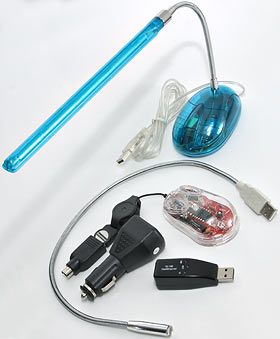
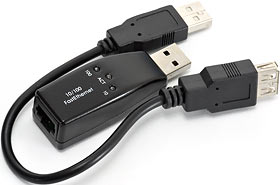
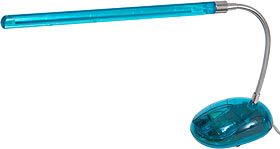

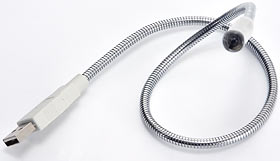
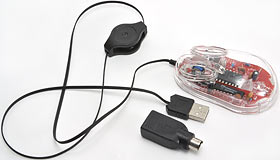
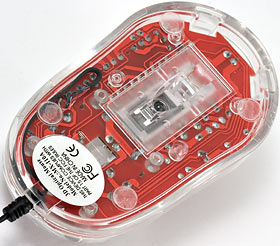

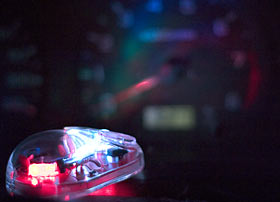

![[SecureWebs]](images/sw.gif)